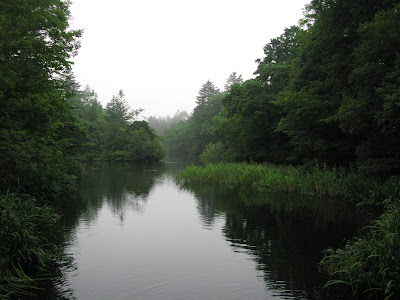Just over an hour from the capital thanks to the Nagano Shinkansen, it's an ideal place to get away from the summer heat of the concrete island that is Tokyo, and last week that's exactly what I did for a couple of days, relaxing in the cooler mountain air.
Being a week day when I arrived, and not yet at the peak of the summer holiday season, the town was remarkably quiet in the daytime, though I imagine that at weekends it's an altogether different story.
There are a fair number of places to visit, some of which can be reached easily by bicycle, as there are numerous places renting them out for the day in the town itself. Some of the other points of interest are a little further afield and to get there you either need access to a car or to the not so frequent buses.
From there it was a bus back into town and then on another bus out to an area called Hoshino which is a fairly recent development that includes an onsen, some classy but tasteful small shops and a hotel. A walk through the woods will also bring you to the modern architecture of the cocoon-shaped stone chapel which was built back in the boom times of the eighties, and just one of the many chapels in the area that make a lot of money from the popularity of western style chapel weddings.





After this it was back into town for a quick look around, though by this time the day trippers had gone home, and it was really like a ghost town, something exacerbated by the heavy mist that enveloped the town like a blanket.





There is a (real) church in memory of Shaw, a street named after him and an annual festival which also carries his name ~ all in recognition of the way that his actions changed the economic fortunes of the area.



 In the woods around the town, you can see lots of house built on very large plots of wooded land, many of which are second residences of the wealthier section of society, though some are also available for seasonal rental.
In the woods around the town, you can see lots of house built on very large plots of wooded land, many of which are second residences of the wealthier section of society, though some are also available for seasonal rental.

 With it's heritage as a resort town owed to the expatriate community of years gone by, as well as the disproportionately large number of western style churches and chapels in the are, many of the eateries in town serve French or Italian food, or their is even the 'domestic sausage' shop selling locally produced German-style sausage and cured meats.
With it's heritage as a resort town owed to the expatriate community of years gone by, as well as the disproportionately large number of western style churches and chapels in the are, many of the eateries in town serve French or Italian food, or their is even the 'domestic sausage' shop selling locally produced German-style sausage and cured meats. I opted for something Japanese in the evening, however, and, lured by the stylish decor and jazz being played with the volume cranked up high, I went to Kawakami An for my evening meal.
I opted for something Japanese in the evening, however, and, lured by the stylish decor and jazz being played with the volume cranked up high, I went to Kawakami An for my evening meal.


 No doubt there are many other much cheaper places to get a bowl of soba noodles, but if this restaurant were in Tokyo, I think I'd be a regular, as it was rather special.
No doubt there are many other much cheaper places to get a bowl of soba noodles, but if this restaurant were in Tokyo, I think I'd be a regular, as it was rather special.
 Along with all the wedding chapels in the area, there are, of course, wedding outfitters too, and this one has a name that seems to reflect the almost Disneyfied fairytale romantic vision that the Japanese have of western-style white dress weddings. Even the walk down the aisle is described in Japanese as the 'virgin road' ~ I kid you not.
Along with all the wedding chapels in the area, there are, of course, wedding outfitters too, and this one has a name that seems to reflect the almost Disneyfied fairytale romantic vision that the Japanese have of western-style white dress weddings. Even the walk down the aisle is described in Japanese as the 'virgin road' ~ I kid you not.For the last morning, I headed back to the Hoshino area to have a dip at the Tombo onsen, which is new and pretty stylish. The other choice would have been to visit the huge outlet mall, the far side of the station, but I decided to leave that to the bargain-hunting families with bored kids in tow.






No comments:
Post a Comment